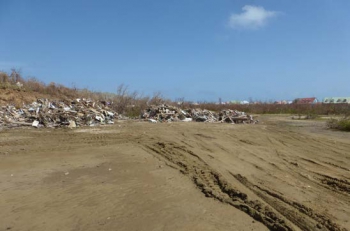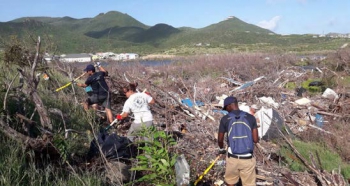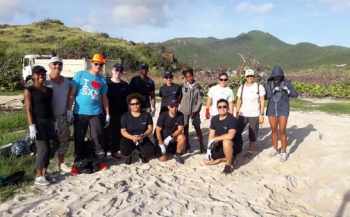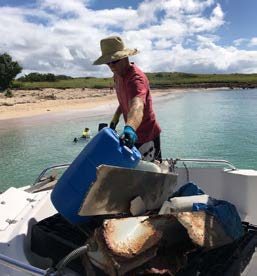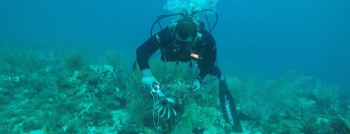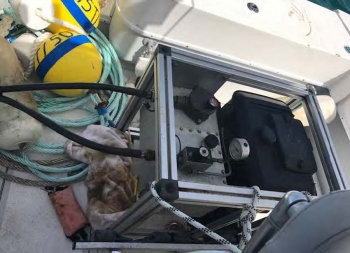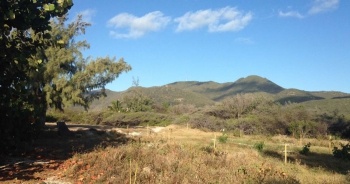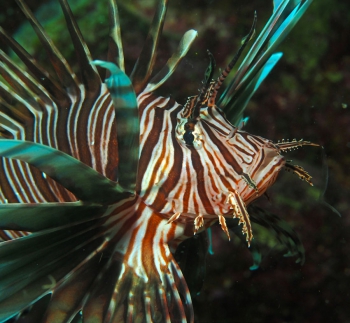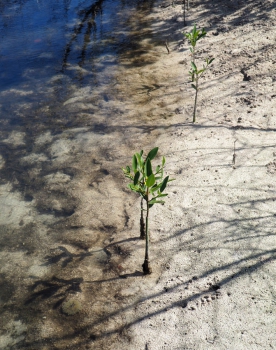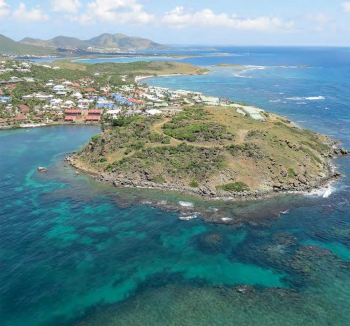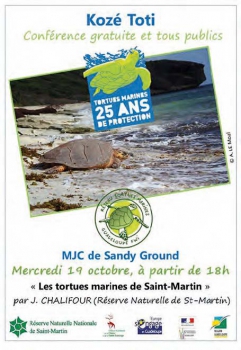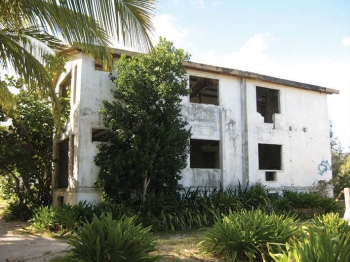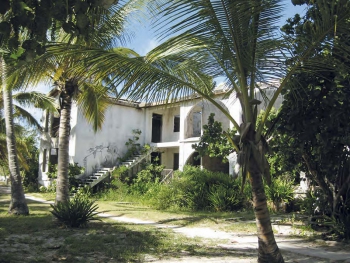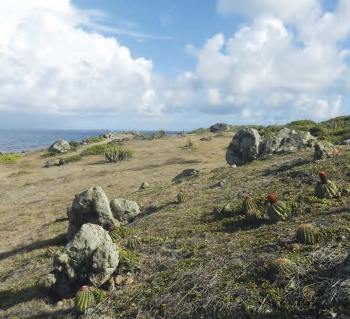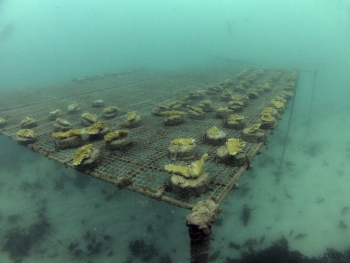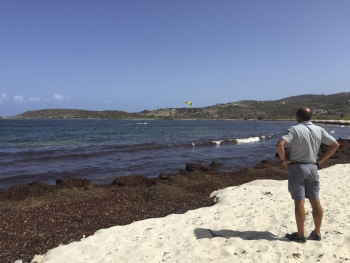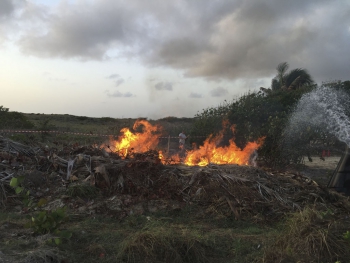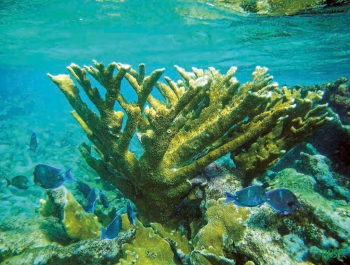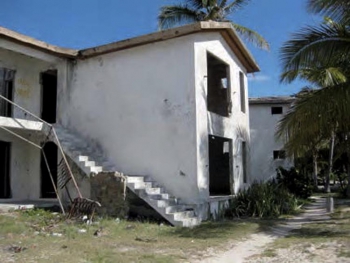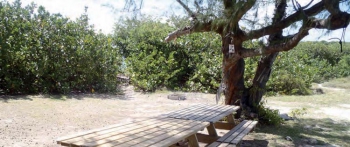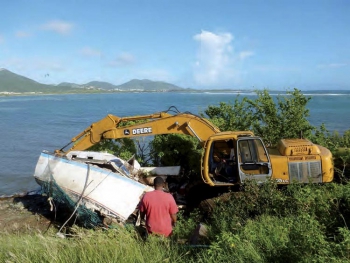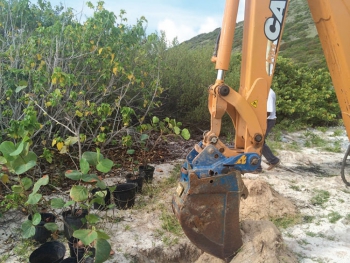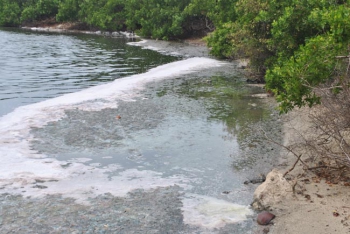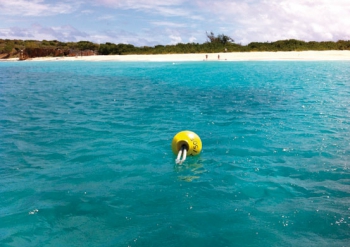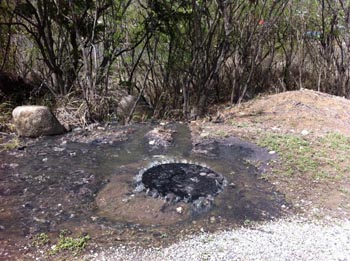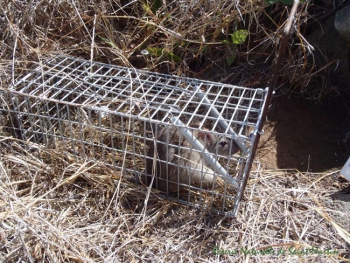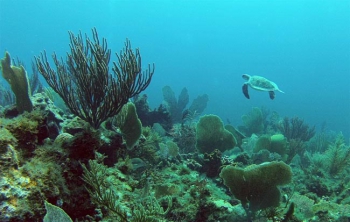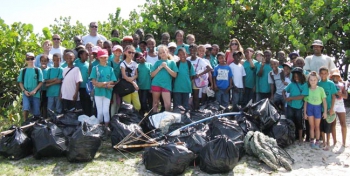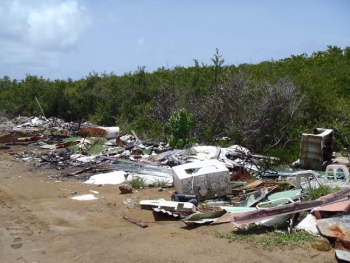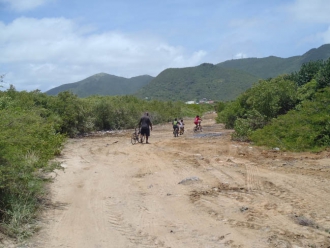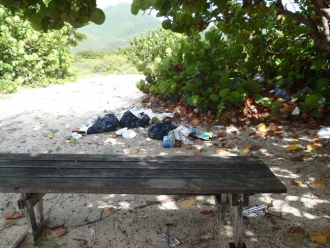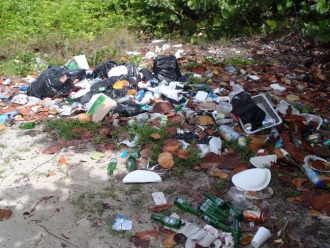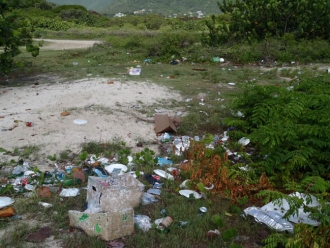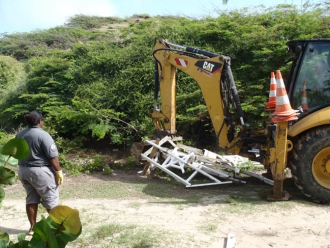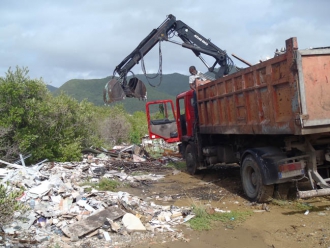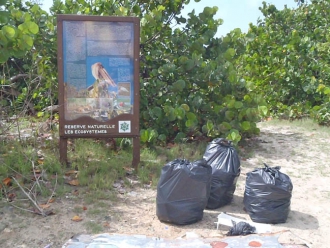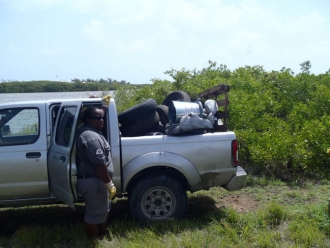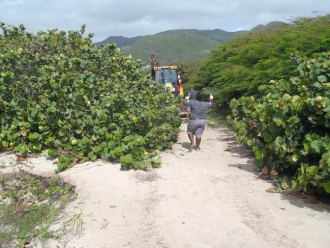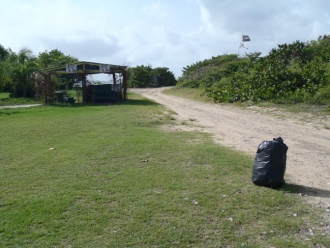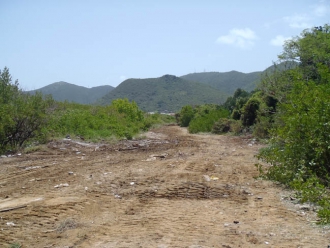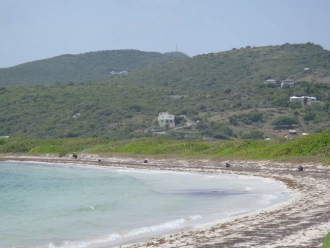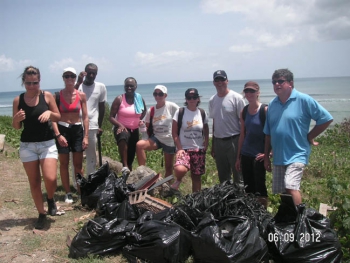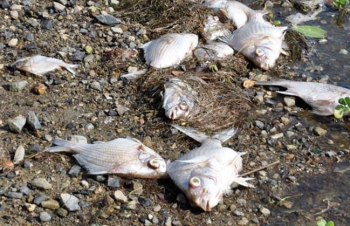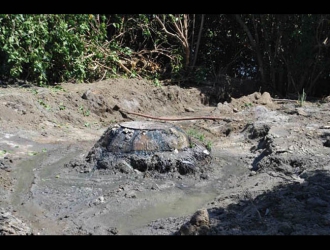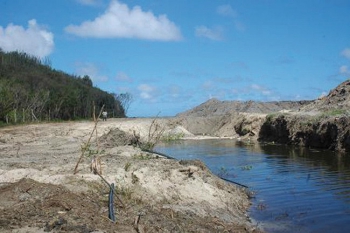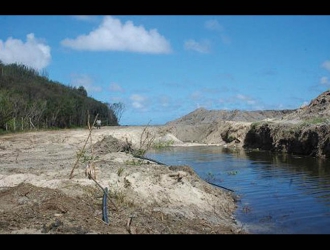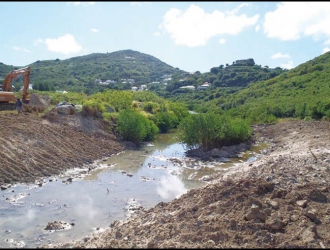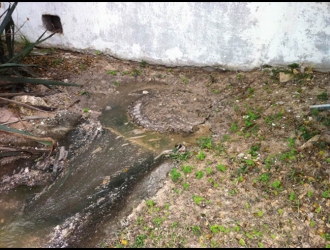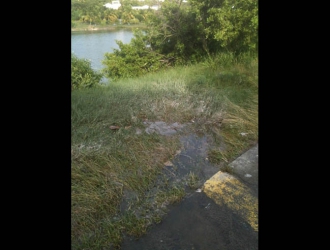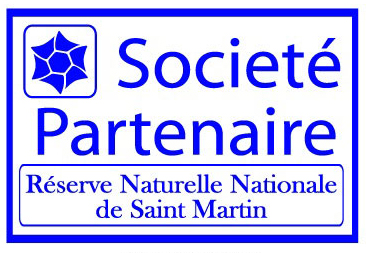In the month of September, P.C., a builder known in Orient Bay, deliberately, without the least authorization and in infraction of the rules of the Réserve, stocked bulky debris collected from Orient Bay along the edges of the Etang des Salines d’Orient, at a site protected as a natural reserve. A report is being sent to the public prosecutor’s office, and the second problem is that individuals have dumped their own trash in the same spot, thinking it was an official place to deposit debris from the hurricane. These debris have been moved since then to the ecosite. Actions de
Restoration Of Degraded Areas And Populations
Restoration Of Degraded Areas And Populations
Restoration Of Degraded Areas And Populations
Repository of an incredible quantity of debris all sizes and all kinds brought by hurricane Irma, the site of Galion has been undergoing regular cleanup operations since the month of October and is returning to its natural colors. In October, the Réserve dedicated several days to the clean up of the Galion beach and surrounding area. The staff, with the addition of 50 volunteers from the group Clean St-Martin, did a remarkable job in collecting and piling the trash collected on the beach along the side of the road, from where it was transported to the eco-site. The staff of the Réserve would like to thank all those from Verde SXM who took care of all this trash for free, Jardinia who provided a dumpster for the cleanup of Galion then took care of transporting it to the eco-site, and the RSMA of Guadeloupe, who cleaned the sides of the road between the Salines d’Orient and the Etang aux Poissons before leaving the island. In November and December, with the help of the association What De 9 and a public works company from French Quarter, the staff of the Réserve cleaned additional areas around the beach. At the same time, also at Galion, four agents of the Réserve collected close to 20 tons of debris by working full-steam for 19 days. The Réserve hopes to make this public beach accessible to the population as quickly as possible. But people will have to be careful where they put their feet, as there is still a lot of debris under the water.
What De 9, a local association in Saint Martin, in partnership with Contour Global, recently contacted the Réserve and offered to help with cleanup operations at natural sites, and also to make a donation of cleaning materials that they can provide: rakes, shovels, tools, gloves… Thanks! At the same time, the association Clean St-Martin showed their strength by undertaking the cleanup of mangrove located behind the former shelters at Orient Bay. This action complements those activities led by the Réserve, as the site in question is located outside of the Reserve’s territory and is covered with debris of all sorts. Clean St-Martin is happy to welcome all volunteers: More details available on the association’s Facebook page.
In mid-December, the Réserve attacked the cleanup of the small island of Pinel, focusing on an area behind the beach to the south where someone had been squatting for more than 20 years with no right to do so. Thus individual was informed that he could gather his personal affairs within two weeks, as the rest of his installation would be burned down. Irma did not spare Pinel: the pontoon and the shelter for the underwater pathway disappeared, as did one of the shelters on the discovery path, the other was essentially destroyed. The first task is to make the site secure by removing the debris that present a danger to the public. In late December, the Réserve went over to Tintamare, where Irma had blown six wooden tables attached to blocks of concrete to behind the beach, causing them to be damaged. The current thinking is to reconstitute four tables using elements that remain from the six original ones. 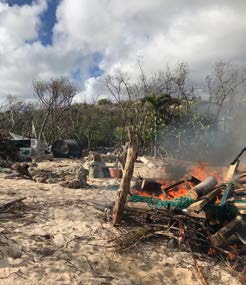
Do lionfish in Saint Martin carry ciguatera or not? On May 23-26, two researchers from the University of Guadeloupe caught these fish in situ, with logistical assistance from the Réserve, and we are awaiting their results. These scientists had hoped to catch 30 of this invasive species at different sites in order to detect the presence of ciguatera in their flesh. They could only capture 16 specimens, as the density of lionfish is much lower in Saint Martin than in Guadeloupe. Why? Perhaps this invasive species has more predators in Saint Martin. The Réserve also gave the researchers another 15 lionfish that had been caught earlier and kept in the freezer. According to Julien Chalifour, director of the Reserve’s scientific department, the answer could be complex, in light of tests done last year by the Réserve. Not only does the place where the lionfish are caught and their age play a role, but also the development of the micro-algae that causes the toxin depends on several factors that are not always present at the same time: the saline content and temperature of the sea water, as well as the general conditions of the milieu, as the algae has a better chance of developing on dead coral.
Comme annoncé dans notre précédente édition, le centre équestre du Galion rouvrira, dans le cadre d’un appel d’offres qui sera prochainement lancé au niveau régional et national. En attendant, le Conservatoire du littoral a décidé de raser le site existant et de transférer le centre équestre sur le site tout proche du refuge pour animaux, illégalement installé sur une parcelle classée en réserve naturelle. Le 10 juin, une société locale de travaux publics a démoli les anciens bâtiments et transporté les gravats, le bois et les métaux à l’écosite de Grandes Cayes, où ces matériaux ont été triés dans les règles de l’art.
17 Buoys In Tip Top Shape at Tintamare
The 17 mooring buoys placed at Tintamare by the Réserve Naturelle have all been repaired. The guards were waiting for an underwater drill to be available locally to do this work, which was completed in late May 2017.
New Interactive Signage
Summer 2017 is a good time for replacing all informative signage within the Réserve Naturelle. The new signs have a QR code that allows anyone with a smart phone to connect directly to the Réserve Naturelle de Saint Martin’s website
The destruction of the former hotel at Galion left a large, open space that the Conservatoire had planned to revitalize for some time.
The idea was to plant various species of trees, before putting in picnic tables, which would benefit from the shade provided by the vegetation. The trees were planted in February and the species were selected from those traditionally found along the edges of the island’s beaches : sea grapes, wild pears, catalpas, and sea-buckthorns.
The current population of lionfish in the waters of the Réserve Naturelle is basically the same as last year.
Every lionfish that is seen is systematically caught by the staff, and it remains to be determined if this invasive species carries ciguatera or not. The analyses done to date have provided results too limited to make a definitive statement on this potential health risk.
Caroline Fleury and Ashley Daniel have replanted the mangrove seeds collected in October 2016 by sixth and seventh graders at Mont des Accords middle school at the Étang de la Barrière.
This environmental gesture will help accelerate the restoration of the mangroves, which suffered on the island during the long period of drought in 2015. The collection of the seeds was part of a field trip led by three representatives of the Réserve Naturelle to mark the 25th anniversary of the protection of sea turtles on all of the French Caribbean islands.
The ecological restoration of damaged areas, and the global replanting of Babit Point are on the to-do list for the Conservatoire du Littoral.
Phase one of the project is to create a botany trail open to the public, with lots of informational signage and an observation point. Enclosed regeneration areas will be built and their placement has already been determined.
Protected legally in Guadeloupe since November 1991 - when they still appeared on the menu in numerous restaurants - sea turtles were in the spotlight during the 25th anniversary celebration of this protective order, which is in effect in all the French Caribbean islands.
In Saint Martin, on October 19, at The Sandy Ground Cultural Centre, the Réserve Naturelle invited the population to «Kozé Toti,» a conference led by Julien Chalifour, head of the Réserve’s scientific department, and Sophie Bedel, from ONCFS Guadeloupe (National Office For Hunting and Wildlife). Students were not excluded from the events: on October 18-21, three representatives met with 6th and 7th grade students from the Mont des Accords middle school, first in their classrooms, then for two field trips on the beach in Galion. These youngsters learned all about the season in which different species of marine turtles lay their eggs and the importance of protecting their nests. The problems in protecting the sites where the eggs are laid were explained to the students: too much light, parking of vehicles, construction that can prevent the turtles from returning to lay their eggs. These field trips concluded with a beach cleaning exercise and collecting of mangrove seeds. These seeds, currently germinating at the Maison de la Réserve Naturelle, will be replanted along the salt ponds on the island, where certain mangroves have suffered from the consequences of El Nino in 2015.
The dismantling of the ruins of the old hotel at Galion is complete.
The demolition of various building began on September 5 and was completed by the end of the month. Initial restoration of this magnificent site is planned by the Conservatoire du Littoral, which plans to consult the population before deciding on the details for the ultimate project here. A first meeting was held with the French Quarter council, and it was decided to set up a small think tank. At the same time, in consultation with the school board, a project has been set up with two French Quarter classes, where the students will participate and make their own suggestions for projects. Julie Walker, representative of the Conservatoire in Saint Martin, met with the two teachers to prepare the project for the students in September 2016. The classes, one in elementary school, the other in middle school, will work on the project in the first months of the school year. The students will learn about the various species that exist on the site, deepen their understanding of the ecosystem, and think about what they would like to see there: the planting of vegetation, for sure, as well as a parking lot for vehicles, and maybe informational signage for the public at large.
The ruins of the old hotel near the beach at Galion will soon be nothing but a disgraceful memory.
The demolition process is underway with two companies doing the work. The first is in charge of removing asbestos from the site, and will come from Martinique. This work, which should take about two months, will begin in April, and the asbestos debris will be sent to France by boat for recycling. The second company will continue the actual demolition by the end of the summer in order to clear the entire site by the end of 2016. The goal of the Conservatoire du Littoral in this project is to restore the damaged areas on this magnificent site and maintain its natural assets, while also planning on improvements to welcome the public. During the work, the Conservatoire will meet with the Collectivité and various users of the site, in order to establish partnerships. A first authorization for temporary occupancy was signed by the Collectivité for the installation of a first-aid station near the floating swimming pool.
Grâce à l’Association syndicale libre d’Oyster Pond (ASLOP) et au Conservatoire du littoral, le site remarquable de Babit Point est retourné à son état naturel...
et le restera. La maison en ruines a été détruite et une clôture mise en place tout autour de la parcelle afin d’empêcher l’accès des véhicules. Il reste à procéder à la restauration écologique des parties dégradées ainsi qu’à l’aménagement d’une petite zone d’accueil au départ du site, ce que prévoit de faire le Conservatoire, qui va prochainement lancer une consultation auprès des riverains. Mais le public est d’ores et déjà invité à découvrir Babit Point, un site venté et aride, où les Melocactus intortus - les fameux «tèt à l’anglé» - abondent et dont la vocation est de rester sauvage.
Work continues in three nurseries for coral that were created in the spring of 2015 in the waters around Tintamare, Caye Verte, and Pinel. It will be a year before it is possible to measure any significant growth of the cuttings, which well secured to their supports, survived the passage of several recent storms without flinching. Generally speaking, after a critical acclimation period of approximately two weeks, the survival rate is 100%. Beforehand, the Réserve carefully selected samples of coral - Acropora sp. and more specifically «staghorn» (Acropora cervicornis) and «elkhorn» (Acropora palmata) - at several sites to ensure good genetic diversity and favorite the resistance of the young colonies. Similar initiatives are taking place in Guadeloupe, Martinique, and Saint- Barthélemy, which is collaborating with Saint Martin in a technical exchange concerning good practices for the health of these nurseries. Lastly, Nicolas Oury, a student at Intechmer in Cherbourg and a future senior oceanographic technician, recently supported his thesis on this subject, which he knows rather well, after spending a five-month training period dedicated to the creation of these nurseries..
Sargassum seaweed… a big subject of conversation these days, for which the Collectivity of Saint Martin knows it must find a sustainable solution. In October 21, 2015, the Réserve Naturelle, which called for meetings all of concerned agencies -the prefecture, the Collectivity, and also the Regional Health Agency (ARS), due to health risks linked to the emission of H2S gas - organized the formation of “green brigades” to find the best solution to treat these mountains of algae that have been continually invading the windward coasts of Saint Martin. It is necessary to spread and dry the sargassum for three or four days so that it loses up to 80% of its volume, before transporting it to the eco-site at Grandes Cayes. As this drying process requires a large surface, the Conservatoire has proposed providing space along the Saline in Orient.
Just this once, the rangers from the Réserve Naturelle intentionally set a fire on the island of Pinel,
with special authorization from the prefecture. The fire was necessary to burn the excess vegetation collected after the passage of hurricane Gonzalo in October 2014, as the debris was too massive – around 100 cubic meters – to allow natural deterioration. With firemen at hand, and help from local restaurateurs, this impressive monticule was reduced to ashes.
Do you know that you can propagate coral like you can propagate a plant? That’s how to create a coral nursery, with the goal of implanting young colonies on the coral reefs that are in bad health. Alizée Masson and Nicolas Oury, two interns at the Réserve Naturelle, were charged with creating the first coral nursery for Saint Martin. The coral in question are Acropora sp, or to be exact, Staghorn coral (Acropora cervicornis) and Elkorn coral (Acropora palmata), both in pretty bad shape but which grow more rapidly than other types of coral - up to almost 4 inches per year. The sites for implanting the coral has been determined, at depths between 15 and 30 feet, in remote spots that are not very visited. This project required numerous dives in order to take cuttings from healthy coral, and to attach them to a solid support, such as rope or wire mesh, until they develop. Alizée, a 21 year-old student in a master’s program for «Ecology, Biodiversity, Evolution» at Paris Sud University, was with the Réserve from March 30 to June 4, 2015, while the internship for Nicolas, a 19 year-old student at the Ecole Intechmer in Cherbourg and a future marine technician, runs from April through August 2015.
Since last August, the Conservatoire du Littoral has been the owner of a piece of land at Galion Bay, where a project is advancing to demolish a hotel that is ruins. Before demolition, an RFP will be issued in the first quarter of 2015 for the removal of asbestos in the various structures. The development of this site, which has an extensive ecosystem but it also very popular with the public, includes parking for a large number of vehicles without impacting the environment. Recreation and fun will not be forgotten, with the installation of picnic areas as well as a fitness trail on the point at the north end of the bay and sports facilities for such activities as beach tennis. The restaurant will be replaced with a smaller and lighter structure.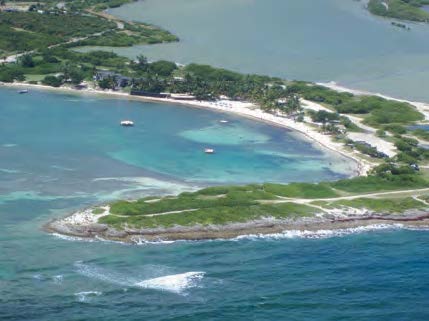
Three coconut palms on Pinel and sadly the magnificent
filao that shaded the picnic tables on the
beach at Tintamare did not resist the high winds
that assaulted the islands during hurricane Gonzalo.
The trees were cut up and any branches that
posed a danger to the public on the beaches within
the Réserve were removed.
Finally! Almost 20 years after it sank not far from the Coralita site, a sailboat damaged by hurricane Luis in September 1995 has been dismantled and transported to the eco-site at Grandes Cayes. It was necessary to wait for the death of the owner, who had been ordered by the court to remove his boat but didn’t have the means to do so, allowing the Conservatoire du Littoral to legally proceed in removing the remains of the vessel. With a hand from Verde SXM, the management company for the eco-site, a 22-ton mechanical shovel was used to cut the boat in two before it could be removed. A much-needed cleanup of the beach, which had been polluted, followed this maneuver.
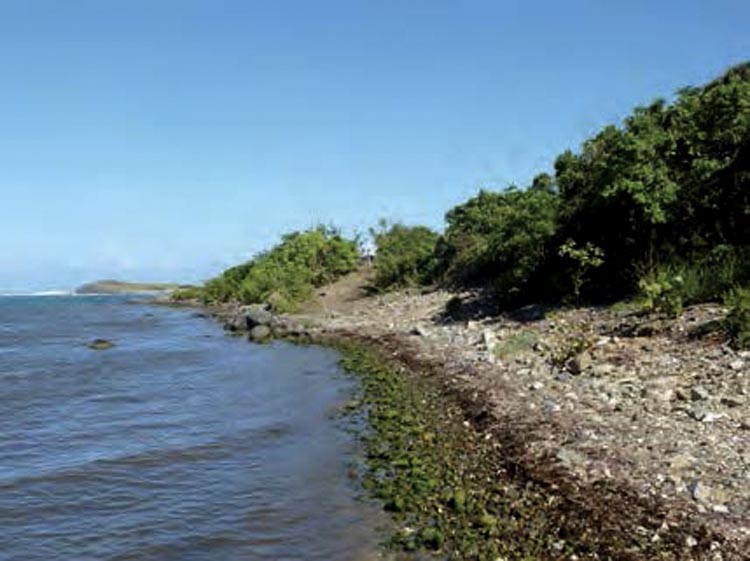
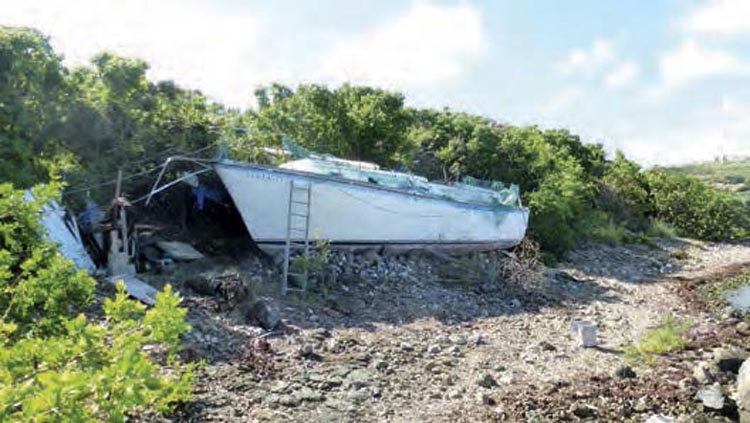
17 foolproof moorings at Tintamare
Replacing mooring buoys, that are often the objects of damage and theft, is something that the Reserve is all too familiar with and have perfected over time. For example, by early May there were only 3 mooring buoys left at Tintamare, the team has now put in 17 new buoys that are connected to their mooring by a cord made of steel and nylon that should resist both boat propeller blades and attempted theft.
207 trees planted at Grandes Cayes
In late May a trench was dug and 207 trees were planted along the beach at Grandes Cayes (between the road and the beach), in order to stop people parking there. Blocks were also erected between the trees to help reinforce the matter. Preference was given to three local tree species – the catalpa, sea grape and almond trees - and now all that’s needed is a couple of years and then site will be covered in shade. This work was carried out by the Nature Reserve and the Conservatoire du Littoral, along with the voluntary help of the company Verde, who manages the Ecosite, and the company Jardinia.
In November 2013, there was once again a situation involving pollution at the Grand Etang, and once again, it was in the same spot on the road where La Samanna Hotel faces the salt pond. Local residents notified the Reserve and the Conservatoire of the profuse amount of untreated sewage pollution that was overflowing onto the road, instead of pouring into the public sewer system. A flushing was conducted and has stopped the problem on a short-term basis, but more substantial work to upgrade the system is vital. On two occasions, in February 2012 and February 2013, the Saint-Martin Water and Sanitation Division (EEASM) presented the hotel with formal notices to proceed with the upgrading of their system; both were unsuccessful in getting any results. The work required consists of installing a waste water pretreatment unit, as the hotel’s waste water contains fibers from the laundry service and fat from the restaurant, which are both perfect for clogging a drainage system and causing this recurrent overflowing. The Nature Reserve, on its side, has drawn up two official statements against the hotel, both in 2009 and in 2013. Several meetings with all the key players have also failed to put an end to this ongoing situation, to the detriment of the salt pond and also the health and safety of the public. The local residents, who are deeply involved in this affair, deplore this pollution that is dragging on. Let us remember that the 14 salt ponds, protected by the Conservatoire du Littoral, managed by the Nature Reserve since 2007, have been designated Wetlands of International Importance under the Ramsar Convention.
Etang Guichard’s story…
The Grand Etang is not the only one to have recurrent cases of pollution. In Friar’s Bay, the Etang Guichard was privy to another episode of pollution at the beginning of December, originating from the private sewage treatment plant of the residence «palmeraie baie», located on its banks. This facility has experienced repetitive failures that pollute the environment, despite several formal notices from the Conservatoire du Littoral and a report from the Nature Reserve. The Reserve is appealing to anyone who witnesses such form of pollution on the salt ponds to call them immediately on 05 90 29 09 72.
n order to avoid the recurrent theft of the mooring buoys around Pinel, the Nature Reserve rangers have replaced the rope that runs from the anchor to the buoy with 12mm chain. In addition, three mooring buoys at Rocher Créole and four at Tintamare have been temporarily removed, as the shackles that are chemically sealed to the mooring are in need of underwater securing.
The unfortunate salt pond in Chevrise had just withstood a proliferation of green algae due to previous
pollution, when it then had to deal with a fresh sewage spill during the long weekend of May
8th. The leak came from an overflowing sewage pipe from a private network along the road to Mont
Vernon. Alerted by , the Reserve and the Conservatoire du Littoral, immediately gave formal notice to
the managing syndicate of the development and the reserve guards made sure the repair was done
quickly. The leak was stopped, but serious vigilance is still to be taken around this wet area that has
already been weakened several times in the past.
211 rats and 79 mice were trapped during a capturing campaign lasting about 2 weeks on the islands of Tintamare, Pinel, Green Cay and Creole Rock. 200 traps were baited with harmless peanut butter and rolled oats, so as not to kill other species other than these rodents. This management campaign for small mammals took place from March 4th to 14th, 2013 and will be carried out again next year at the same time, just before egg-laying season. It was organized by the Reserve, along with the support of three researchers from the National Institute of Agronomy Research (INRA) and the National Museum of Natural History, as well as an intern in his 2nd year of Masters at the University of Antilles- Guyane. Introduced onto the islands, these rodents who just love birds’ and turtles’ eggs, pose a threat to the reproduction of the Brown Noddy and Tropicbirds and they also attack Gaiac trees by devouring its seeds. The objective of this campaign and conservation of these classified natural areas was to complete the inventory of the species present on the islands, initiated in 2010, and also to reduce pest populations. Further analysis will allow a better understanding of the two target species - genetic characteristics, reproductive cycles - and thus better identify their impact on the Reserve.
The Tintamare rat and the Pinel rat
As in La Fontaine’s fable, the difference between the Tintamare rat and the Pinel rat are their waistlines. Restaurants and visiting tourists ensure daily rations for the rodents on Pinel, while their brothers on Tintamare fight over a sliver of a sandwich. It is therefore paramount on each island to make sure that no food waste is left at the end of the day, and that everyone takes their garbage home. Any food supply is a godsend for these rodents, who tend to proliferate in the vicinity of the sites most frequented by the public and may represent a health risk - parasites and infectious diseases, and an environmental risk - attack on sensitive animal populations and plants. More than ever, enjoy the natural areas of the reserve, but be careful not to leave anything behind nor take anything (except your garbage!) from a protected area.
Nicolas Maslach, the Reserve’s Conservationist, accompanied by Julien Chalifour, Head of the Scientific Department, participated in a video conference in Guadeloupe, with the Ministry of Environment. The agenda was dedicated to the progress of the National Plan for the restoration of marine turtles, and to its actions. The conference was held in the presence of DEAL Guadeloupe (Environmental Management Body) and the National Office for Hunting and Wild Fauna (ONCFS), who are responsible for monitoring this plan in Guadeloupe. On the other side of the Atlantic, in their office in La Defense, near to Paris, a representative of the Ministry and marine turtle specialists listened to Eric Delcroix, Project Manager of marine turtles for ONCFS Guadeloupe, who explained that the plan at present has been 50% completed. It includes raising awareness of the public, police actions to control and fight against poaching, the promotion of alternative fishing techniques to limit unwanted turtle captures, efforts to involve fishermen in the implementation of the plan, media publication of information, and finally monitoring stranded turtles in trouble (see article following page). Monitoring the quality of the sites is part of the plan and takes into account the environmental condition of the site; if vehicles are traveling near it or not, if there are spotlights, if the upper beach has vegetation... For Saint-Martin, our representatives explained the difficulties particular to our island, such as the sustainability of the Eco Volunteers Network, composed largely of teachers who leave for other destinations at the end of their three or four year contract. Also, health care for injured animals is sorely lacking, just as the administrative complications for species with an endangered status make it almost impossible to transport an injured turtle to Guadeloupe. A request for technical and financial assistance has been put forward in the form of setting up a primary health care center in Saint-Martin, with a local point of veterinary assistance. This establishment would allow a recovered animal a place in captivity to receive an initial diagnosis, to stabilize its condition, and then to decide on whether or not to send it to Guadeloupe, or to release it at sea, possibly after a period of care.
Killed by a boat propeller
On March 20th, 2013, an injured Green Turtle was rescued in Marigot by the Reserve team and Claire Saladin, veterinarian, thanks to the vigilance of passersby and employees at the Marina Fort Louis. This juvenile turtle - under 25 years old - showed signs of a violent collision with two boat propellers. Its fractured left shell revealed a gaping wound on its back. Despite the care provided by the mobilized team, «Marigot» was to die from a cardiac arrest the following week. The accident meant she would never get to reproduce, and this loss is invaluable when you know that less than one egg in a thousand, for these endangered reptiles, reach 25 years old, the age when a turtle has its first chance to reproduce and come and nest on our beaches.
Speed limited, turtles protected
The presence of marine turtles on the coastline and the development of boating in Saint-Martin are certainly not without risks. Although these reptiles are aquatic they have lungs, which require them to frequently come to the surface to breathe. This is where they are most vulnerable to the risk of collisions. Reducing speed near the coast will guarantee the safety of the vessel, other users, and also many animals that frequent our shores: whales, dolphins, birds and turtles. The regulation is very clear: in the 300m band, the speed of any engine is limited to 5 knots, about 9 km/h. Three species of sea turtles live in the waters of Saint-Martin. Green Turtles, Hawksbill and Leatherback Turtles all feed here and breed annually from March to October.
When in a collision or if you see a dead or injured animal, please immediately call the Saint- Martin Nature Reserve (05 90 29 09 72 / 06 90 34 77 10), head of the local network for stranded sea turtles, so that action can be taken. No legal proceedings will be taken against those responsible for the collision, so there is no excuse for not reporting the accident. Do not try to move the animal. Remember to provide key information: number of animals, precise location, time of the last observation, movement or lack thereof, visible lesions or not, and contact information for further details if necessary. Every report could help save a turtle.
40 bags of 200 liters filled with garbage from the sea… that was the result of the beach cleanup at Galion!
It was organized by the Prevention of Youth Delinquency Brigade (BPDJ) together with two classes from Elie Gibbs School in Grand Case, one from CE1 and the other from CM1 along with their teachers.
Thanks to gifts donated by some sponsors, the two gendarmes from the BPDJ organized the operation into a form of competition whereby the 47 children were grouped into teams of six and combed the coastline clean.
Only the section of the beach belonging to the Conservatoire du littoral (Coastal Conservancy) and classed as part of the Nature Reserve was concerned, that being the area after the Surf Club and up to the whale observatory in Coralita (the wildest part of the beach).
A reminder: The Conservatoire du littoral is in the process of acquiring other parcels of land; ones that have already been assigned to it through a process of expropriation.
Antitheft anchorages off Pinel Island
At Pinel, to avoid recurring theft of mooring buoys, rangers from the Nature Reserve replaced the leading strings from the mooring buoys with 12mm chain.
In addition, three mooring buoys at Creole Rock and four at Tintamare were temporarily withdrawn, as the chemically sealed ring on the moorings require underwater repairs to ensure security.
It took four days for 10 agents from the Collectivity, three rangers and the director of the Réserve Naturelle to get to the bottom of the trash dumped at Galion, but the result was worth the wait.
The Collectivity provided a truck with a crane and a backhoe in order to clean the entire site, comprising the beach, the area behind the beach and the dirt path that leads to French Quarter.
Those on the clean-up squad worked like demons to collect 20 tons of diverse trash—forgotten items from picnics, old cans, appliances, rubble, car bodies, building materials, old furniture—that was accepted free of charge at the eco-site at Grandes Cayes. Large volcanic rocks have been put in several places to impede future access by vehicles.
Thursday, September 6 was World Cleanup Day for all the Radisson Hotels around the world, and the Radisson in Anse Marcel decided to spend the day cleaning up the beach at Petites Cayes and the Chemin des Froussards, both located in the heart of the Réserve Naturelle.
Equipped with garbage bags, a dozen employees of the hotel —including the general director—followed the path that their clients regularly go on, along with two rangers from the Réserve.
They picked up every little bit of trash they could find during a two-hour walk.
Although the site was not overly polluted, the hotel workers managed to fill several trash bags and remove some larger items that had washed up on shore and eventually all was taken to the trash collection eco-site at Grandes Cayes.
Officially they are well protected - they are the beneficiaries of a biotope protection order, they belong to the Littoral Conservancy, are managed by the Réserve Naturelle, and since May 1, 2012 are even listed under the Ramsar Convention - and yet the 14 ponds are still, in reality, under an enormous amount of pressure and threats: depositing of debris as well as assorted trash and refuse, untreated water from septic systems, unauthorized cutting of the mangroves...
In fact, just during the first quarter of 2012, the Salines d’Orient, the Etang aux Poissons, the Etang de Grand Case, The Etang de Chevrise and the Grand Etang des Terres Basses were all victims of recurring pollution, primarily due to malfunctions in public and private septic systems, some of which caused the death of hundreds of fish.
Reason enough for the Littoral Conservancy and the Réserve Naturelle to implement a strict, but necessary, surveillance.
Each time they see that polluting waters flow into the ponds, a well-defined procedure is put into place immediately: identification of the sources; analysis of the water if necessary to define the origin of the pollution; seeking out of those responsible, public or private; and rapidly finding a way to put a stop to the cause of the pollution.
If those at fault turn a deaf ear, the next step is a formal letter with a precise deadline to fix the problem. And if nothing is done by the time of the deadline, the matter becomes a legal issue with an official report presented by a warden of the Réserve Naturelle in the name of the police of the waters.
In 2011, eight instances of pollution were followed up on, three of which resulted in formal letters and official reports.
Since the beginning of 2012, five ponds have been polluted; six formal letters and two official reports were presented.
The 14 ponds in Saint Martin, which constitute part of the wetlands in the Réserve Naturelle, were included in the Ramsar Convention in recognition of their international ecological importance, such as, for example, the Camargue in France and The Everglades in Florida.
This international recognition confirms the importance of our island’s natural heritage, which includes the ponds and wetlands.
It also illustrates the huge responsibility of the Réserve in terms of the protection and promotion of these zones.
With this in mind, the Littoral Conservancy and the Réserve Naturelle are creating a trail to explore the mangroves in the Etang de la Barrière in Cul de Sac.
En janvier 2012, au sud de la plage de l’Anse Marcel, le remblais déposé illégalement en 2009 à l’embouchure du petit étang a été enlevé et le talus aplani, permettant de nouveau une meilleure communication entre l’étang et la mer.
Ces travaux ont été réalisés par le contrevenant, qui avait également arraché une partie de la mangrove à la même époque et avait alors été mis en demeure par la Réserve naturelle de remettre les lieux en état.
La végétation de type invasif qui recouvrait le remblais a été défrichée, mais il reste à planter des palétuviers dans la mangrove et des raisiniers en arrière plage, ainsi que des espèces caractéristiques de la forêt sèche.
Une pollution qui n’en finit pas
Alerté le 5 janvier 2012 par l’association des riverains des Terres Basses, Romain Renoux, le directeur de la Réserve naturelle, a constaté sur place un écoulement d’eaux usées répugnantes dans le Grand Étang des Terres Basses, en bordure d’un hôtel.
Le dysfonctionnement est apparemment dû au débordement d’un poste de relevage et n’est pas nouveau. Déjà en 2009, la Réserve naturelle avait dressé un procès-verbal au contrevenant.
La Réserve naturelle a contacté l’Établissement de l’eau et de l’assainissement de Saint-Martin (EEASM), qui a tenté de diagnostiquer le problème.
Une rencontre a été organisée sur le site entre la Réserve, la direction de l’hôtel, la préfecture, l’EEASM et la Générale des Eaux, en vue de résoudre définitivement la question, selon les préconisations de l’EEASM.
L’équipe de la Réserve reste très vigilante au sujet de cette pollution, le Grand Étang constituant un patrimoine naturel d’exception et totalement protégé.

